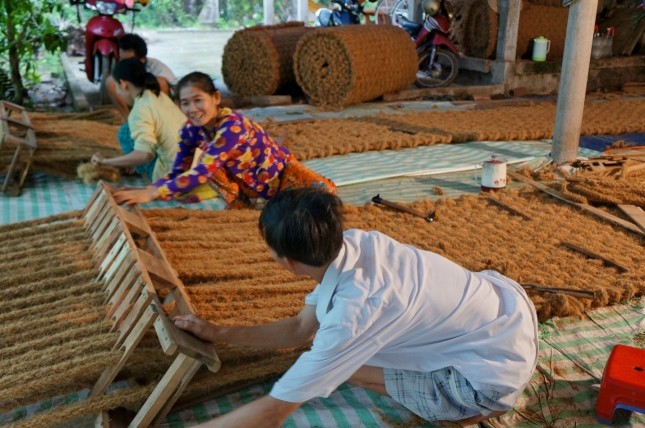( Update: 04/01/2019 )
The two provinces of Ben Tre and Vinh Long are considered to have the most coconut in the Mekong Delta. People here take advantage of all the ingredients of coconut trees to make a local industry with diverse products, including carpets from coconut fiber.

First of all, they buy coconut from the gardeners then take it to the professional coconut peeling facility. They must take time to separate the outer skin of the coconut. Every day a worker can split up to 1,200 coconuts. They then sold coconut shells to coconut fiber carpet factories. In addition, in the Mekong Delta provinces, coconut shells are a very effective combustion material. Photo: Le Van Hieu

Transporting coconut shells to factories is one of the jobs that contribute to income generation for local people. Photo: Nguyen The Vinh

At factories that make products from riverside coconuts, it is easy to see images of people using this machine during the drying process to beat the peeled coconut fiber winch. Photo: Nguyen The Vinh

The coir fiber will be put into a puree machine to soften the yarn before putting it in a winding machine. Each stage requires thorough implementation. Otherwise, the coir fiber will be rough and cannot produce a beautiful and smooth carpet as expected. The process of making steps from coir fiber requires workers to wear masks to avoid inhaling dust from coconut fiber. Photo: Le Van Hieu

At local coconut coir plants, coconut shells are placed in a large iron cage to win winches. After separating the coconut shell, it is put into the beating machine to become a yarn and then to the net tube before drying it. When passing through this mesh tube, tiny cocopeat particles will fall down from the coir group. This grid is filmed all day without any time limit. Photo: Le Van Hieu

After beating coconut fiber as shown above, workers will put them on this machine. Next, the coir fiber will be put into a shaft like the threshing machine to distribute evenly, then the machine will automatically wrap the thread and make it into a small coconut fiber. Photo: Le Van Hieu

This machine has an internal part that functions to beat coconut fiber. This stage helps people save a lot of time and costs. On the side of the machine there is a roll to automatically wrap into each disorder only coconut fiber. Photo: Le Van Hieu

This is a factory made of coir fiber from Trung Nghia commune, Vung Liem district, Vinh Long province. This area borders Ben Tre province. From small coconut fiber just inside the machine, they will use a 4-piece combination machine to twist only into a larger thread and then the two big threads will twist into a big thread (as shown in the picture) . Photo: Le Van Hieu

Yarns are only wrapped in rolls so that people can easily bring them to the carpet making places. Photo: Le Van Hieu

After having a large coconut palm thread, the thread spinning people attached to the frame before braiding. The thread is very thick and firm. Photo: Le Van Hieu

Each coconut fiber thread is attached to each round hole of the braided frame. The form is like a mat. This stage seemed simple, but it was really hard. The big coir fibers will hurt the hands of the workers. Photo: Le Van Hieu

Usually, the couple will work together on the same weaving frame as a mat. Each person has a wooden hammer and knocks the thread to hard it into the carpet. (Horizontal mats 1.0m x10m or 1.2m x10m or 1.5m x10m. Each pair can make 2 to 3 carpets daily.)
The wooden braided frame is lifted up regularly to thread the threads horizontally. The work of making coir carpets contributes to income for family members and many local households. Photo: Le Van Hieu

The hard thing to do is to keep the carpet tense, the surface smooth and not rough. Photo: Le Van Hieu

After the carpet is finished, people will burn the feather at the edges for a smoother product. They use gas cylinders and stubble to burn all the tiny hairs on the carpet surface before being rolled up and delivered to export establishments. Photo: Le Van Hieu

They then rolled the carpet and sold it to local factories. This is one of the export products from coconut trees of Ben Tre and Vinh Long provinces. Photo: Le Van Hieu